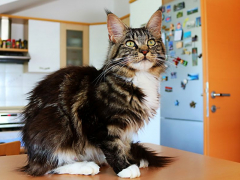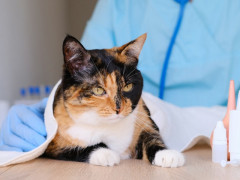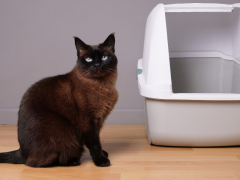
RJ22/Shutterstock.com
Cryptococcus is a fungal infection and is considered to be the most common systemic fungal disease that occurs in cats. It occurs worldwide and is caused by the fungus Cryptococcus neoformans/Cryptococcus gattii species complex, whose spores can infect cats via inhalation or wounds and cause disease.
Cryptococcus has four different forms in cats, and so the symptoms can be very variable, from sneezing to seizures. The treatment chosen by your veterinarian will therefore also depend on what form they have. In this article we’ll discuss everything that you need to know including causes, common symptoms and how it’s treated.
Causes of Cryptococcus in Cats
Cryptococcus in cats is caused by a complex of fungal species called Cryptococcus neoformans/Cryptococcus gattii. Although fungal infection is a rare cause of disease in cats, cryptococcus is the most common systemic fungal infection that occurs in the feline species. But how do cats get this fungal infection? We’ll explain now.
Inhalation of Spores
Disease occurs when cats inhale the spores of this fungus and it enters their body. Infected spores can be found in contaminated environments, such as from bird droppings, particularly in that of pigeons, or decaying vegetation, especially decaying Eucalyptus leaves.
Entry Through Open Wounds
Most spores enter the body through the nasal cavity but they can also gain entry through open wounds. Cats with injuries or skin conditions, may be at more risk of this as they are more likely to have open wounds.
There are some suggestions that cats with a compromised immune system may be more susceptible to infection. This includes cats with feline leukemia virus (FELV), feline immunodeficiency virus (FIV), cats receiving chemotherapy, and cats with severe infections.
Symptoms of Cryptococcus in Cats
As we learnt above, usually spores are inhaled through the nasal cavity and therefore gain entry into the body through the upper respiratory tract. The nasal cavity is the first location of the fungus and hence the nasal form of cryptococcus is the most common. There are four forms of cryptococcus and each have different symptoms, we’ll discuss these further now;
Nasal Form
This is the most common form of cryptococcus in cats and includes symptoms such as:
- Nasal discharge
- Sneezing
- Swelling on the nose
- Nasal wounds
- Difficulty breathing
- Louder breathing
- Masses in the nasal cavity
- Weight loss
- Change in appetite
- Lack of balance
- Ear infection/inflammation
Nervous Form
This can occur when the infection from the nasal from extends into the central nervous system.
- Seizures
- Sudden blindness
- Behavioral changes, such as hiding away or disorientation
- Spinal pain
Skin (cutaneous) Form
- Single or multiple skin nodules on or below skin
- Not itchy
- Not painful
- Lymph node (gland) enlargement
Systemic Form
- Joint inflammation
- Changes to eyes
- Changes to bones
- Multi-organ disease (including liver and kidney failure)
- Lethargy
- Anorexia (not eating)
Complications of Having Cryptococcus in Cats

Cats with the nervous or systemic forms of Cryptococcus may suffer more severe symptoms and require more intensive treatment. Maria Sbytova/Shutterstock.com
Cats with the nervous or systemic forms of cryptococcosis may be at more risk of complications.
The nervous form, involving the central nervous system (CNS), may cause increased intracranial pressure, which can lead to brain damage if it isn’t corrected in time. It can also cause meningoencephalitits – inflammation of the brain. Involvement of the brain or spinal cord may result in a poorer prognosis and outcome.
The systemic form can lead to multi-organ disease which can ultimately cause multi-organ failure in some cases. Therefore, both of these forms can develop severe complications and be fatal.
Diagnosis of Cryptococcus in Cats
If your cat is showing any of the signs above, schedule a check with your veterinarian. Early diagnosis is key to treating this disease. They will take a thorough history from you and examine your cat.
To diagnose feline cryptococcosis, multiple tests can be performed. In particular, a test called the latex agglutination test (LAT) is useful in diagnosing cryptococcosis. This is an cryptococcal antigen detection test that is carried out on a sample of the cat’s blood, urine or cerebrospinal fluid (CSF).
If this test is negative but cryptococcus is still suspected, tissue biopsies may be taken to send away for analysis at an external laboratory. Other tests that may be used by your vet to diagnose this condition include cytology (examining slides under a microscope), culture, polymerase chain reaction (PCR) and antibody detection (serology test).
Cats can show a variety of clinical signs with cryptococcus, depending on the form they have. Your vet will need to differentiate this from other conditions and may recommend routine blood (including FELV and FIV testing) and urine work to check for underlying disease. They may also recommend further imaging including x-rays, CT, MRI or rhinoscopy.
Treatment for Cryptococcus in Cats
The treatment for cryptococcus involves antifungal medication. Treatment is given for several months to a year in most cases. The treatment will depend on the form of cryptococcosis that your cat has and the severity of the symptoms.
The main drugs used to treat cryptococcosis in cats includes; amphotericin B, ketoconazole, fluconazole and itraconazole. Fluconazole and itraconazole are usually used for mild cases and need to administered for many months. On average fluconazole is given for 4 months while itraconazole is given for 9 months but this can vary on a case by case basis. Contact your vet if your cat is having any side effects to the medication such as an upset tummy.
Cases where the nervous or systemic forms are involved may require extra medication such as amphotericin B. Cats with the cutaneous (skin) form of the condition may require surgery to remove skin lesions. This will aid in your cats recovery. Your vet will decide on your cat’s medication and dose depending on the form that they have and their symptoms.
Medication is usually continued until the antigen test is negative. If it’s not possible to repeat the antigen test, the medication should be continued for 2-4 months after clinical signs have resolved. Cats that have had cryptococcosis will need to be monitored long term as relapses can sometimes occur.
Cat Care Tips
It can be very worrying when your cat has been diagnosed with cryptococcus but don’t worry, we have some cat care tips to help them with their recovery.
- Persevere with the medication: cryptococcus requires a long course of medication to treat it. This can often be from a couple of months to a year long course depending on their progress. Don’t be tempted to give up with treatment – stick to the medication schedule, it will pay off in the long run.
- Regular veterinary check-ups: your cat will need regular check-ups with their vet while they’re receiving medication for cryptococcus. Your vet will advise you on how often these should be but they’re usually once monthly in most cases and aid in the evaluation of treatment.
- Easier access to resources: cats with cryptococcus, particularly the nervous or systemic forms, may feel lethargic or have affected mobility. Ensure that these cats have easy access to their resources. Resources include food bowls, water bowls, beds, litterboxes, scratching posts and human company.
- Encourage eating and drinking: if you’re cat isn’t eating well, particularly with the nasal form as this may cause congestion, you may need to encourage them to eat and drink. Provide tasty food in their favorite bowls and warm it up if necessary.
Prevention of Cryptococcus in Cats

Cryptococcal spores are found in contaminated environments, so good hygiene is essential. Ondacaracola/Shutterstock.com
As we’ve mentioned above, cryptococcus is caused by cats inhaling spores, often from bird (particularly pigeon) droppings and decaying vegetarian. Both indoor and outdoor cats are susceptible as cryptococcus is an airborne pathogen so can easily spread away from its main source. There are some precautions we can take to try and prevent this from happening to our cats.
- Keep cats away from areas that housed pigeons are kept. This may reduce the risk of cats inhaling spores from the droppings.
- Outdoor cats are more likely to come in contact with bird droppings and decaying vegetation. Keeping cats indoors if possible may reduce the risk of exposure to spores.
- Spores can gain access through open wounds or sores. If you notice your cat has an open wound, schedule a check-up with your vet as soon as possible to get it treated.
- Keep your cats regular vaccinations and preventative healthcare up to date. Cats that are immunocompromised may be at more risk. Regular vet care will keep your cat as healthy as possible, along with a high quality diet and an optimum weight.
- Practice good hygiene in the home. Clean areas regularly including any bird droppings or decaying vegetation.
Frequently Asked Questions
How do you treat cryptococcus in cats?
Cryptococcus in cats is mainly treated with antifungal therapy for several months. Some cats may require surgery to remove skin nodules if they have the cutaneous form.
What are the symptoms of cryptococcus in animals?
Symptoms will vary depending on the form of cryptococcosis that your cat has. Most cats will have the nasal form which causes nasal discharge, sneezing, nasal swelling, nasal wounds and difficulty breathing.
Can you get cryptococcus from cats?
No cryptococcus isn’t zoonotic, meaning that it won’t transfer from cats to humans. It’s also a non-contagious disease.
How did my cat get cryptococcus?
Cats can get cryptococcus from inhaling infected spores from contaminated environments. Environments that contain bird droppings (in particular pigeon droppings) or decaying vegetation potentially have greater risk of transmission.
What is the prognosis for cats with cryptococcosis?
The prognosis for cryptococcosis in cats is good if it diagnosed and treated early. The nervous or systemic forms can be more complicated however and the prognosis isn’t as good with these forms.







